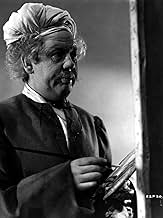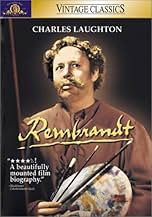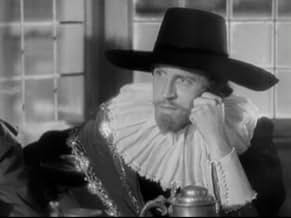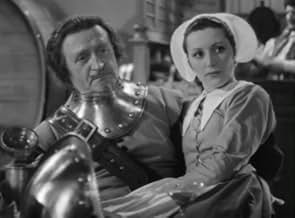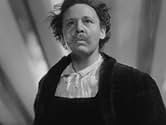Füge eine Handlung in deiner Sprache hinzuThe respected painter takes to drink and faces down scandal after his wife dies.The respected painter takes to drink and faces down scandal after his wife dies.The respected painter takes to drink and faces down scandal after his wife dies.
- Regie
- Drehbuch
- Hauptbesetzung
- Auszeichnungen
- 1 wins total
Empfohlene Bewertungen
The story takes us through Rembrandt's sad life, and manages at the same time to leave out a lot of sadness. The film shows his son Titus, but there were several other children who did not survive. The great tragedy of Rembrandt's life was the death of his wife Saskia, whom he painted often. Rembrandt was also known for asking Jews to pose for his Old Testament paintings, which are informed by his knowledge of the Bible.
There were two other women in Rembrandt's life: his common-law wife Hendrickje Stoffels (Elsa Lanchester) and his housekeeper, Geertje Dirx (Gertrude Lawrence) who evidently became his lover. She later sued Rembrandt for breach of promise, and he had to pay her 200 guilders a month. For years he tried to get her committed.
Rembrandt is shown falling into poverty here. When his fortunes dimmed as an artist, he continued to work as a teacher. Bad investments were the main cause of his problems. In truth, his paintings remained popular throughout his lifetime, and the one for which he is chastised in the film actually was a huge hit.
Laughton portrays Rembrandt as a man of tremendous artistic integrity, a learned man with soul, heart, and a great feeling for language. Indeed, Laughton's monologues are absolutely beautiful; had he read the phone book, I would have been just as enraptured. Elsa Lanchester is very young here, all eyes, and gives a very sweet performance as the frail Hendrickje. Gertrude Lawrence is an absolute spitfire as Geertje.
Wonderful film. Don't miss this breathtaking Laughton performance.
Charles Laughton's performance is truly great, portraying Rembrandt's vision and artistic integrity (which appears as perverse stubbornness to his fellow citizens), and his deep humanity. His speeches at the inn which mirror each other at the beginning and end of the film, on the glory of perfect love and the vanity of human life, are so beautifully delivered I almost held my breath so as not to miss a word.
More than that, the film succeeds in recreating Rembrandt's world. We see the business-like merchants, self-important local politicians and hard-living peasants who made up Dutch society in the 1600's. One of the most moving passages of the film shows Rembrandt trying to return to his home. He is physically unsuited to his father's work and derided by the villagers. He returns to Amsterdam realising he can't fit in with the merchant-class or the peasant-class where he was raised - he is a man alone.
The supporting cast is noteworthy, including Elsa Lanchester (Mrs Laughton, of course) as Rembrandt's last love, Gertrude Lawrence (although I'm still not sure why audiences seemed to fall in love with her, maybe her histrionics were more suited to theatre) and a large crop of Liveseys (Roger, Jack, Sam - I'm sure there were others).
Later biographical pictures, Lust for Life about Van Gogh and Moulin Rouge about Toulouse-Lautrec had good location photography going for them. Alexander Korda did create some nice sets to depict the Netherlands of the 17th century, but it just isn't the same.
Another difference between Rembrandt and the other two later pictures is while Van Gogh and Toulouse-Lautrec died young, Rembrandt lived to be an old man by the standards of his century. The film takes us on a forty year journey of his life from the death of his first wife until just before he dies. Laughton is great at capturing Rembrandt at every stage of his life.
As compared to those other two 19th century artists, Rembrandt's life was also not the tormented one the others had. Rembrandt is not a deformed cripple like Toulouse-Lautrec nor is he dealing with the onset of mental illness like Van Gogh. Tragedy happens in his life, but the tragedy isn't out of his own character.
Like the other two Rembrandt was constantly plagued with money problems. That's actually what takes up most of the film, the compromises he makes with his artistic vision and the need he has to put bread on the table.
Gertrude Lawrence and Elsa Lanchester do fine as the two women in his life. Laughton and Lawrence did not get along during the making of Rembrandt, that may have helped give their scenes some real bite. Three members of the performing Livesey family are in this film and Roger Livesey is a standout as the beggar who Rembrandt uses to paint his portrait of King Saul from the Old Testament.
Rembrandt is a finely crafted piece of film making and Charles Laughton gives one of his best screen performances. I wish though it had been done on location the way Lust for Life and Moulin Rouge were.
Additionally, it was shot very nicely. Keep in mind that this is a very old movie, but the black and white photography is put together in an almost Rembrandt way.
If you haven't seen Rembrandt then go and get it. You won't be disappointed. Well done!
Wusstest du schon
- WissenswertesSam Livesey, the father of three other actors in this movie--Roger Livesey, Barry Livesey, and Jack Livesey--died the day after this film was released in London.
- PatzerWhen Rembrandt reveals the newly completed painting, 'The Night Watch', we see not the full, original version that he in fact painted, but the drastically butchered version that was made over 40 years after his death, when the painting was moved from its original exhibition space in the Kloveniersdoelen to a less capacious display space in the Amsterdam Town Hall in 1715.
- Zitate
Rembrandt van Rijn: And of a sudden he knew that when one woman gives herself to you, you possess all women. Women of every age and race and kind, and more than that, the moon, the stars, all miracles and legends are yours. Brown-skinned girls who inflame your senses with their play, cool yellow-haired women who entice and escape you, gentle ones who serve you, slender ones who torment you, the mothers who bore and suckled you; all women whom God created out of the teeming fullness of the earth, are yours in the love of one woman.
- Crazy CreditsOpening credits prologue: In the seventeenth century Holland was a world power, her ships carried treasure to Amsterdam from all parts of the earth. But her proudest glory was the son of a miller from Leyden, Rembrandt Van Rijn, the greatest painter that has ever lived. He died in obscurity, his belongings no more than a few shillings.
Today no millionaire is worth the money the works of Rembrandt would realise, if ever offered for sale.
- VerbindungenFeatured in Dumb Dora Discovers Tobacco (1945)
Top-Auswahl
- How long is Rembrandt?Powered by Alexa
Details
- Erscheinungsdatum
- Herkunftsland
- Sprache
- Auch bekannt als
- Büyük Ateş-Rembrandt
- Drehorte
- Denham Studios, Denham, Buckinghamshire, England, Vereinigtes Königreich(Studio, uncredited)
- Produktionsfirma
- Weitere beteiligte Unternehmen bei IMDbPro anzeigen
- Laufzeit1 Stunde 25 Minuten
- Farbe
- Seitenverhältnis
- 1.37 : 1


